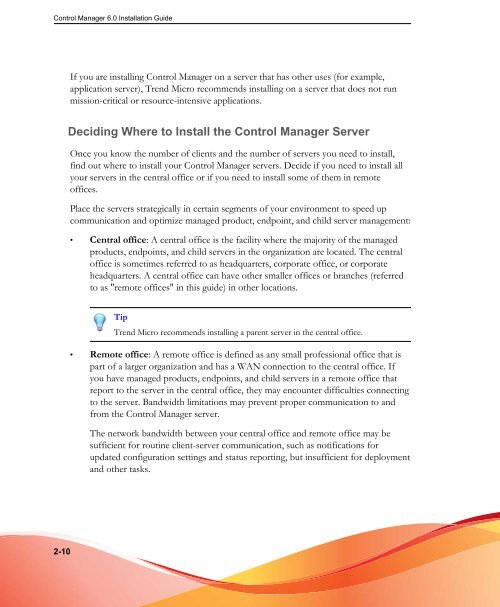Control Manager Installation Guide - Trend Micro? Online Help
Control Manager Installation Guide - Trend Micro? Online Help
Control Manager Installation Guide - Trend Micro? Online Help
You also want an ePaper? Increase the reach of your titles
YUMPU automatically turns print PDFs into web optimized ePapers that Google loves.
<strong>Control</strong> <strong>Manager</strong> 6.0 <strong>Installation</strong> <strong>Guide</strong><br />
2-10<br />
If you are installing <strong>Control</strong> <strong>Manager</strong> on a server that has other uses (for example,<br />
application server), <strong>Trend</strong> <strong>Micro</strong> recommends installing on a server that does not run<br />
mission-critical or resource-intensive applications.<br />
Deciding Where to Install the <strong>Control</strong> <strong>Manager</strong> Server<br />
Once you know the number of clients and the number of servers you need to install,<br />
find out where to install your <strong>Control</strong> <strong>Manager</strong> servers. Decide if you need to install all<br />
your servers in the central office or if you need to install some of them in remote<br />
offices.<br />
Place the servers strategically in certain segments of your environment to speed up<br />
communication and optimize managed product, endpoint, and child server management:<br />
• Central office: A central office is the facility where the majority of the managed<br />
products, endpoints, and child servers in the organization are located. The central<br />
office is sometimes referred to as headquarters, corporate office, or corporate<br />
headquarters. A central office can have other smaller offices or branches (referred<br />
to as "remote offices" in this guide) in other locations.<br />
Tip<br />
<strong>Trend</strong> <strong>Micro</strong> recommends installing a parent server in the central office.<br />
• Remote office: A remote office is defined as any small professional office that is<br />
part of a larger organization and has a WAN connection to the central office. If<br />
you have managed products, endpoints, and child servers in a remote office that<br />
report to the server in the central office, they may encounter difficulties connecting<br />
to the server. Bandwidth limitations may prevent proper communication to and<br />
from the <strong>Control</strong> <strong>Manager</strong> server.<br />
The network bandwidth between your central office and remote office may be<br />
sufficient for routine client-server communication, such as notifications for<br />
updated configuration settings and status reporting, but insufficient for deployment<br />
and other tasks.

















